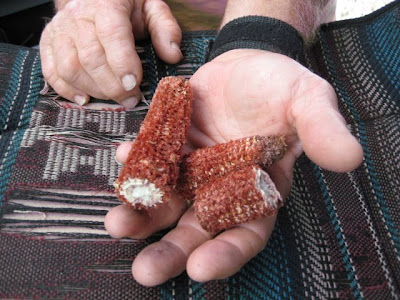 10/8/07 (Monday):
10/8/07 (Monday): Hello from Kankakee, Illinois. We enjoyed a day on two different Illinois tallgrass prairies today, and I have some pictures for you.

But first, I want to share some fall foliage pictures I took before we left Muskegon.


I tried to set them up as a slide show for you, but apparently there's not a way to do that on blogger.com.


This one was actually taken through my living room window!

That's a lot more color than we've seen since we left Michigan! It's still pretty green here.

Okay--now to the prairie pictures. We were a little disappointed. I'm not sure what I thought a prairie was going to look like, but it just looked like a big pasture to me! We went to Medewin and Goose Creek prairies. Both are tall grass prairies. The soil is very rich and up to 10 feet deep, so the grasses grow very deep roots to tolerate drought. This is bluestem grass, one of the most common kinds.


There were lots of butterflies and a few wildflowers.


This little blue butterfly seemed to be feeding on the dung!


This little cabin was reconstructed by high school students. It was originally built in the mid-1800's and nicknamed "The Palace" because it had two stories. The owners often played host to travelers passing through the area. The little pond was dug by glaciers 10,000 years ago. The boulders were moved along with the glaciers and dropped here when the glacier melted. There were similar boulders scattered all over the prairie. They're called "glacial erratics."

The predominant plant species on prairies is, of course, grass. The tallgrass prairies we visited had many different types of grasses--big bluestem, little bluestem, and cordgrass to name a few I remember.

Different species of wildflower are associated with different kinds of grasses. Unfortunately, almost all the wildflowers had gone to seed, like this milkweed. I'll bet it's gorgeous in the spring!


There were osage orange trees everywhere, both on the prairies and along the fence lines of farms in the areas. We used to find these trees every fall near our beach cottage. They're peculiar things--big as grapefruit. My father told me that the farmers used osage orange wood posts for fences, and they sprouted! Don't know if that's true or not, but they do seem to grow along old fence lines.


Here's one last prairie shot--the sky was quite dramatic!


The trip today was through farmland that was almost entirely planted in corn.

The barns were fantastic!


We watched many fields being harvested. A big machine gathered the corn, stalks and all.


Then this other machine brought just the kernels and loaded them into a truck. Don't ask me how it happened, but that's what we saw.

Wiley picked up these little stripped ears in the street after the machine turned around.

That's all for now folks. Tomorrow (if we can get an internet connection) we'll blog from the St. Louis, Missouri, area.

 That's a lot more color than we've seen since we left Michigan! It's still pretty green here.
That's a lot more color than we've seen since we left Michigan! It's still pretty green here.


 The predominant plant species on prairies is, of course, grass. The tallgrass prairies we visited had many different types of grasses--big bluestem, little bluestem, and cordgrass to name a few I remember.
The predominant plant species on prairies is, of course, grass. The tallgrass prairies we visited had many different types of grasses--big bluestem, little bluestem, and cordgrass to name a few I remember.



 We watched many fields being harvested. A big machine gathered the corn, stalks and all.
We watched many fields being harvested. A big machine gathered the corn, stalks and all.



2 comments:
Very informative and interesting blog, Joyce. I think you did a good job of getting some prairie shots, even if it wasn't quite like you imagined it would be.
It's been a long time since I've seen milkweed pods -- when I was a kid, we used to gather as many of the dried pods as we could and save them for an especially windy day. We'd then break them open, letting them blow away in the wind. We thought that was a lot of fun!
Fascinating bit of info about the fruit-bearing fence posts. Can't wait for your next blog!
Thanks, Julie. I had a lot of trouble writing that blog. For some reason, it just didn't seem to flow like previous ones. The photos look a lot better than the real thing!
Post a Comment